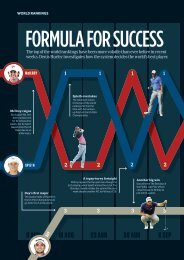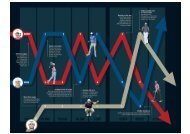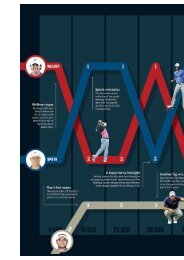GW_December_Preview
Create successful ePaper yourself
Turn your PDF publications into a flip-book with our unique Google optimized e-Paper software.
DECEMBER 2015, ISSUE 13 VOL 5 6 | JASON DAY WORLD EXCLUSIVE | GOLF'S NEW BIG THREE | RORY'S EXEMPTION | US OPEN CRISIS | HIGH-TECH DRIVERS TEST | FIX BUNKER FAULTS | SPAIN AND PORTUGAL<br />
HIGH-TECH DRIVER TEST<br />
CALLAWAY GREAT BIG BERTHA v TAYLORMADE M1 v COBRA KING LTD<br />
A RYDER CUP<br />
WITHOUT RORY<br />
Why the European Tour had<br />
to give McIlroy a free pass<br />
GOLF’S NEW<br />
BIG THREE<br />
WORLD EXCLUSIVE<br />
A MAJOR<br />
IN CRISIS?<br />
Why Spieth, McIlroy and Day<br />
Why the stature of the<br />
could dominate for years<br />
US Open is under threat<br />
JASON DAY<br />
The incredible untold story of his rise from<br />
drunken teenage street fighter to World No.1<br />
THE UNLUCKIEST GOLFERS OF ALL TIME > GOLF IN<br />
SPAIN & PORTUGAL > THE GREATEST SEASON EVER<br />
FIX YOUR<br />
BUNKER<br />
FAULTS<br />
3 ways to cure your<br />
fear of the sand!<br />
PAGE 64<br />
DECEMBER 2015 £4.50
GOLF WORLD EXCLUSIVE<br />
DRUNKEN<br />
TEENAGE<br />
STREET<br />
FIGHTER<br />
TO WORLD<br />
NO.1<br />
The incredible, untold story<br />
of Jason Day. By Ben Everill.
GOLF WORLD<br />
TEST<br />
TECHNOLOGY-PACKED<br />
Increased attention to adjustability and centre-of-gravity location characterise the new<br />
TAYLORMADE<br />
M1<br />
£429<br />
It is typical of golf’s dark sense of humour that,<br />
just as enhanced statistical analysis can now<br />
prove that the key to lowering scores is piling on<br />
the distance, golf club engineers have run out of<br />
ways to make drivers more powerful.<br />
Or have they? Yes, it is true that the 0.83 COR limit<br />
agreed by the R&A and USGA in 2002, which limited<br />
spring-like effect on the clubface, effectively drew a line<br />
under increased driver power. But there are other<br />
avenues to increased distance than speed off the face,<br />
and modern driver R&D is pursuing them relentlessly.<br />
Take for example the clubhead’s balance point, or centre<br />
of gravity. Its position within the head influences launch<br />
angle, spin rate and the efficient transfer of energy from<br />
clubhead to ball… in other words, distance. The<br />
attention engineers give to perfecting this location in all<br />
three drivers on test is a neat illustration of how the<br />
modern war on short drives is being waged.<br />
To this we can add the optimising of trajectory, often<br />
likened to being able to increase the reach of a hosepipe
EQUIPMENT<br />
ADJUSTABLE DRIVERS<br />
driver launches from TaylorMade, Callaway and Cobra. But how will they compare?<br />
CALLAWAY<br />
GREAT BIG<br />
BERTHA<br />
£369<br />
COBRA<br />
KING LTD<br />
£349<br />
PHOTOGRAPHY BY BOB ATKINS<br />
not by turning the tap, but by adjusting the hose’s angle.<br />
Launch and spin control ball flight, and the ability to<br />
customise and fine-tune these distance-gaining launch<br />
parameters through adjustability is in evidence in all<br />
three drivers on test.<br />
We can also consider what we call forgiveness,<br />
technicians call MOI and marketeers are now terming<br />
‘speed protection’ – in other words, new technology<br />
designed to add power to our mishits by spreading the<br />
legal maximum for spring-like effect into the various<br />
dark corners of the clubface.<br />
Together, these features paint a picture of the<br />
modern big dog that has added brains to its bridled<br />
brawn – a precision-engineered tool that packs a punch<br />
not just with its big, bony forehead but also with the<br />
grey matter behind it. The three latest driver launches<br />
– TaylorMade’s M1, Callaway’s Great Big Bertha and<br />
Cobra’s King Ltd – are excellent examples of this more<br />
cerebral approach to bombing it. But how would they<br />
compare on the range, course and launch monitor?
INSTRUCTION<br />
TOUR INSTRUCTION<br />
My 5 Best<br />
Lessons<br />
Alejandro Canizares<br />
The two-time European Tour winner shares his<br />
favourite tips and drills that he uses every week.<br />
ALEJANDRO<br />
CANIZARES<br />
World ranking: 158<br />
Scoring: 70.59 (25th)<br />
Driving accuracy:<br />
67.8% (24th)<br />
GIR: 68.8% (66th)<br />
Putts per GIR: 1.74 (23rd)
INSTRUCTION<br />
1<br />
If<br />
Get a shallow attack for more distance<br />
you can hit the ball a long way, you<br />
can gain a significant advantage. I’ve<br />
never been a ‘big hitter’ because my<br />
natural swing has tended to involve<br />
hitting down on the ball, which is great<br />
for the irons but not so good for<br />
launching the driver with the high<br />
launch and little spin that you want.<br />
Bubba Watson’s attack angle is +4°,<br />
while I’m nearer -3°. Sergio Garcia is<br />
about the only great driver who hits<br />
down on the ball.<br />
I’ve been working with Mike Walker<br />
for four years and he’s helped me to<br />
understand my swing much better. He<br />
gets me to do this drill a lot with the<br />
driver to help me shallow my swing<br />
and get closer to the level or ascending<br />
attack angle that will improve my<br />
launch conditions and help me improve<br />
my driving distance.<br />
Place an alignment stick<br />
in the ground about three<br />
feet behind you and a<br />
foot ahead of your ball<br />
position. Make sure<br />
you’re not going to hit it.<br />
The stick works as a visual<br />
aid to swing under in the<br />
downswing, which<br />
encourages you to attack<br />
the ball with a level or<br />
ascending angle.<br />
<strong>December</strong> 2015 Golf World 59
A STEP<br />
TOO FAR<br />
FOR THE<br />
US OPEN?<br />
The USGA’s Mike Davis has made it his personal mission to<br />
transform the image of the US Open by taking the championship to a<br />
wider variety of golf courses. But was the decision to go to Chambers<br />
Bay in June just a little too ambitious, asks Jock Howard?
72 HOURS IN…<br />
Barcelona<br />
Combined with its culture, cuisine, football and nightlife, the capital of Catalunya<br />
and its environs is one of Europe’s finest city breaks, as Chris Bertram discovers.<br />
There aren’t many things<br />
Barcelona cannot offer the<br />
visitor, and a terrific long<br />
weekend’s golf break is certainly not<br />
one. There are enough pleasant<br />
courses to occupy your time within<br />
the city itself but we broaden the<br />
catchment area in order to highlight<br />
golf of an especially high calibre – on<br />
only one day here does it stretch your<br />
travelling to the hour mark though.<br />
On each day we highlight at least<br />
36 holes – and we know there are<br />
plenty of you who will relish such a<br />
heavy schedule. But our feeling is that<br />
perhaps 27 holes on day one (at a<br />
course helpfully boasting five loops<br />
of nine) followed by a choice of one<br />
of the two courses we suggest on day<br />
two and then finishing with 36 on<br />
the further-flung courses on the final<br />
day will not leave many wanting for<br />
more quality or quantity.<br />
In addition, of course, the city has<br />
myriad non-golfing attractions,<br />
whether it be the beach and port, its<br />
two football teams or the history and<br />
beguiling architecture. Or you might<br />
just like to hang out on Las Ramblas,<br />
the wide, bustling avenue in the heart<br />
of the city where whole afternoons<br />
are so easily and enjoyably lost.<br />
With regular and cheap flights<br />
into El Prat, on the southern edge<br />
of the centre, it is a very convenient<br />
trip as well as an enticing one.<br />
El Prat’s Open layout is used for<br />
the Open de Espana on the<br />
European Tour, won by<br />
Englishman James Morrison.
COURSES<br />
DAY ONE<br />
El Prat (Open & Rosa)<br />
This historic club, the home of Pablo<br />
and Alejandro Larrazabal, was initially<br />
located right next to the city’s airport but<br />
had to move when runways were added.<br />
The members discovered a huge plot<br />
of gently undulating, forested land due<br />
north of Barcelona near Terrassa.<br />
Greg Norman was invited to lay out<br />
the new course and the members must<br />
be delighted with how what must have<br />
been a difficult transition has developed.<br />
Indeed, you could actually spend all<br />
72 hours of your trip here, play golf<br />
almost all day and not encounter the<br />
same hole twice. There are 45 holes at<br />
El Prat and although the Valles nine is<br />
generally used for practice, the holes are<br />
full length and perfectly good stuff.<br />
We are suggesting just one day here<br />
though, which allows you to play the<br />
other 36 holes. If that seems an arduous<br />
start, you can play 27 and still experience<br />
both the Open combination – the two<br />
loops played for the Open de Espana –<br />
and the Rosa that features at No.36 in<br />
our Continental European Top 100.<br />
Adding to the slightly bewildering<br />
amount of golf that El Prat offers is the<br />
fact the loops have two names; one in<br />
Spanish, one in Catalan. We’ll use the<br />
Spanish with their Catalan in brackets.<br />
Our favourite combination is the Rosa,<br />
which sees the Bosque (Bosc) team up<br />
with the Arriba (Dalt). It is, as all the<br />
loops are, tough. But it also has real<br />
charm, with the Bosque nine in our view<br />
the best balanced of all the sections here.<br />
Set down on relatively flat land, it<br />
weaves in and out of a mature pine forest.<br />
During the tree-lined phases it appears<br />
seriously tight but there are plenty of<br />
sets of tees to select so you need not be<br />
hitting driver off every tee.<br />
The Arriba is on more open but<br />
undulating terrain, with plenty of<br />
cleverly-designed holes where bunkering<br />
adds definition and strategic questions.<br />
Notable moments include the awesome<br />
Montserrat mountain view from the 8th<br />
tee, the tough short 2nd with a terrific<br />
view of the city, the sporty par-4 6th and<br />
the long par-4 7th with the sole water<br />
hazard hard to the right of the green.<br />
The Arriba is also the ‘second’ loop<br />
played during the Open de Espana, with<br />
the front nine of the Abajo starting with<br />
a stiff two-shotter that sets the tone.<br />
The longest of the loops at 3,800<br />
yards is further stiffened by large clovershaped<br />
bunkers. It is not a dour test<br />
though, with a cute short hole at the 3rd<br />
and another nice par 3 at the 8th, where<br />
Señor Jimenez had his jig of delight at<br />
his hole-in-one there earlier this year.<br />
If you want 36 holes, the Piscina loop is<br />
solid too, laid out between the sprawling,<br />
modern clubhouse and Abajo.
WORLD RANKINGS<br />
FORMULA FOR SUCCESS<br />
The top of the world rankings have been more volatile than ever before in recent<br />
weeks. Denis Hurley investigates how the system decides the world’s best player.<br />
McILROY<br />
1 1 1<br />
1<br />
McIlroy reigns<br />
By August 9th, he’s<br />
been number one<br />
for 52 consecutive<br />
weeks, but he hasn’t<br />
played since the US<br />
Open due to an<br />
ankle injury.<br />
Spieth overtakes<br />
The American moves<br />
to the top of the world<br />
rankings for the first<br />
time with his runnersup<br />
finish at the US PGA<br />
Championship.<br />
SPIETH<br />
2 2 2 2<br />
Day’s first major<br />
The Aussie holds off Spieth in<br />
the US PGA Championship to<br />
go from 5 to 3 in the world.<br />
A topsy-turvy fortnight<br />
McIlroy regains the top spot even though he<br />
isn’t playing, when Spieth misses the cut at The<br />
Barclays. Spieth retakes the summit the next<br />
week despite another MC to McIlroy’s T29.<br />
Another big win<br />
Day wins the The Barclays in<br />
the FedEx Cup Play-offs to<br />
close the gap to McIlroy to<br />
just 0.9 of a point.<br />
3<br />
3<br />
3<br />
3<br />
9 AUG<br />
DAY<br />
16 AUG 23 AUG 30 AUG 6 SEP
Resting to the top<br />
McIlroy again replaces<br />
Spieth at the top the<br />
following week even<br />
though neither of them<br />
play due to the FedEx Cup<br />
Play-offs rest week.<br />
1 1<br />
2 2<br />
3 3<br />
Third number one<br />
in three weeks<br />
Day wins the BMW<br />
Championship to climb to the<br />
top of the world rankings for<br />
the first time in his career.<br />
FedEx champion<br />
Spieth’s Tour Championship victory earns him a $10 million<br />
bonus and thrusts him back to the top of the world.<br />
13 SEP 20 SEP 27 SEP<br />
When the idea of this<br />
article was first<br />
discussed back in mid-<br />
August, Jordan Spieth<br />
was on the verge of<br />
taking over from Rory McIlroy at the top<br />
of the Official World Golf Ranking<br />
(OWGR). The young Texan achieved that<br />
by finishing runner-up to Jason Day at the<br />
US PGA Championship, while McIlroy<br />
finished down the field in 17th place. But<br />
no one could have predicted the<br />
rollercoaster ride that was to come as the<br />
title of World No.1 changed hands six<br />
times in just seven weeks.<br />
Spieth’s initial reign was short-lived,<br />
lasting just two weeks before a missed cut<br />
at The Barclays enabled McIlroy to regain<br />
the lead without even playing in the<br />
tournament. The pair continued to<br />
exchange the top spot in unusual<br />
circumstances for the next three weeks.<br />
Then Jason Day joined the party.<br />
While McIlroy and Spieth were<br />
swapping turns at the top of the ranking<br />
without actually setting the world on fire<br />
with their golf, the Australian was tearing<br />
it up. Three victories in a five-week period<br />
from mid-August to the third week in<br />
September saw him reach number one for<br />
the first time. Day’s position at the peak of<br />
world golf only lasted one week, however,<br />
as Spieth rediscovered his game and his<br />
putting to dominate the Tour<br />
Championship, win the FedEx Cup and<br />
finish the PGA Tour season as<br />
World No.1.<br />
As entertaining as this all has<br />
been to watch, it does beg the<br />
question: How and why did so<br />
many changes result and what,<br />
in particular, causes the<br />
anomalies of changes<br />
without the participants<br />
playing? The answer is, as<br />
you would probably imagine, rather<br />
complicated. In layman’s terms, however,<br />
the OWGR is calculated on a two-year<br />
rolling system, which awards and deducts<br />
points from a player’s tally each week. This<br />
means that during any given week, a player<br />
will receive points for their performance,<br />
while the points from two years ago are<br />
deducted. Despite missing the cut at the<br />
Deutsche Bank, Spieth lost fewer points<br />
than McIlroy, who would have needed a<br />
top-10 finish to stay number one. The<br />
following week, McIlroy’s loss was less<br />
severe than Spieth’s and so he was able to<br />
pass him again.<br />
The OWGR is the brainchild of<br />
Mark McCormack, the founder of<br />
IGM, and was introduced at the 1986<br />
Masters at Augusta. Bernhard Langer<br />
<strong>December</strong> 2015 Golf World<br />
55

















